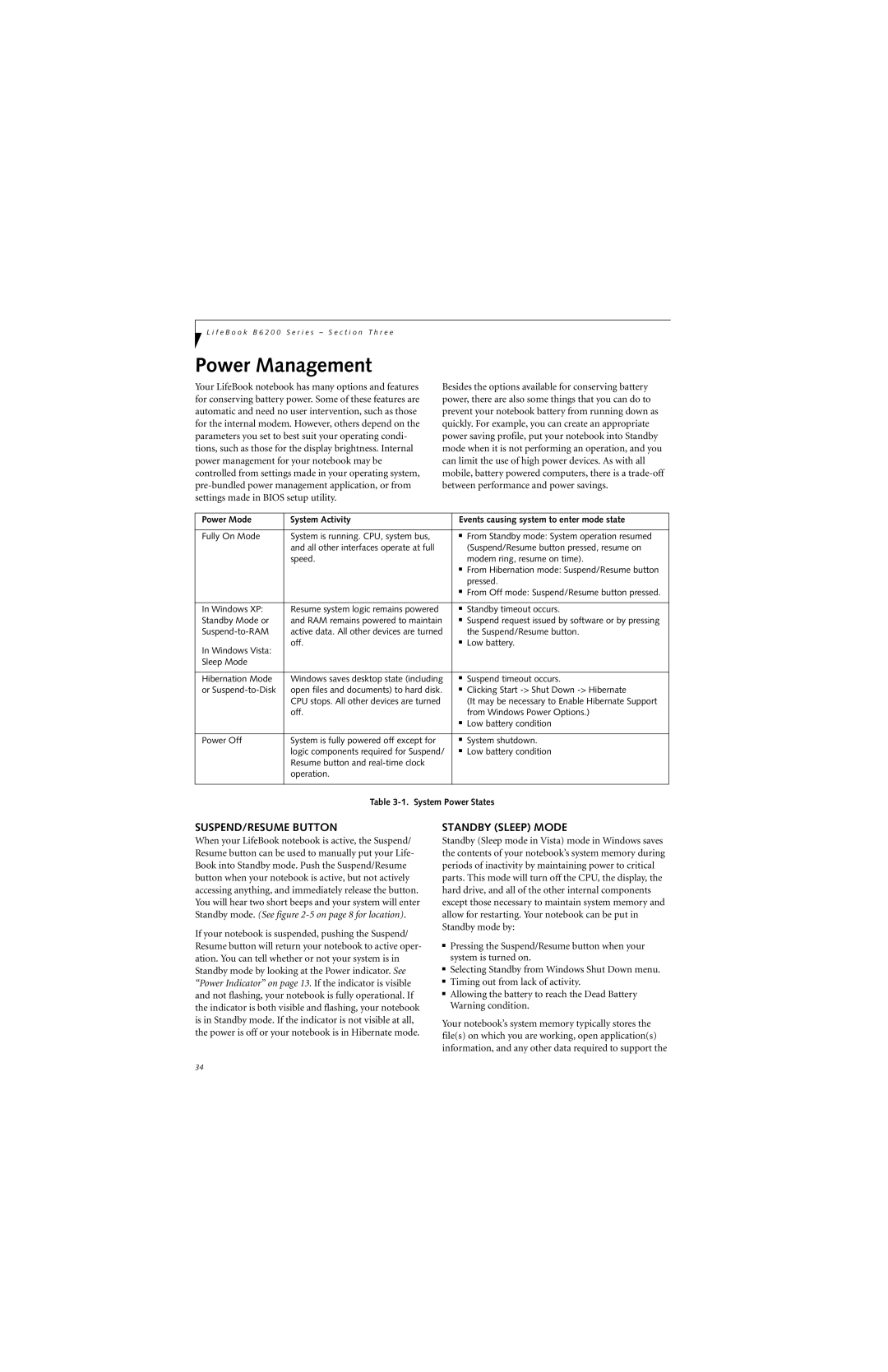L i f e B o o k B 6 2 0 0 S e r i e s – S e c t i o n T h r e e
Power Management
Your LifeBook notebook has many options and features for conserving battery power. Some of these features are automatic and need no user intervention, such as those for the internal modem. However, others depend on the parameters you set to best suit your operating condi- tions, such as those for the display brightness. Internal power management for your notebook may be controlled from settings made in your operating system,
Besides the options available for conserving battery power, there are also some things that you can do to prevent your notebook battery from running down as quickly. For example, you can create an appropriate power saving profile, put your notebook into Standby mode when it is not performing an operation, and you can limit the use of high power devices. As with all mobile, battery powered computers, there is a
Power Mode | System Activity | Events causing system to enter mode state | |
|
|
|
|
Fully On Mode | System is running. CPU, system bus, | ■ | From Standby mode: System operation resumed |
| and all other interfaces operate at full |
| (Suspend/Resume button pressed, resume on |
| speed. |
| modem ring, resume on time). |
|
| ■ | From Hibernation mode: Suspend/Resume button |
|
|
| pressed. |
|
| ■ | From Off mode: Suspend/Resume button pressed. |
|
|
|
|
In Windows XP: | Resume system logic remains powered | ■ | Standby timeout occurs. |
Standby Mode or | and RAM remains powered to maintain | ■ | Suspend request issued by software or by pressing |
active data. All other devices are turned |
| the Suspend/Resume button. | |
In Windows Vista: | off. | ■ | Low battery. |
|
|
| |
Sleep Mode |
|
|
|
|
|
|
|
Hibernation Mode | Windows saves desktop state (including | ■ | Suspend timeout occurs. |
or | open files and documents) to hard disk. | ■ | Clicking Start |
| CPU stops. All other devices are turned |
| (It may be necessary to Enable Hibernate Support |
| off. |
| from Windows Power Options.) |
|
| ■ | Low battery condition |
|
|
|
|
Power Off | System is fully powered off except for | ■ | System shutdown. |
| logic components required for Suspend/ | ■ | Low battery condition |
| Resume button and |
|
|
| operation. |
|
|
|
|
| |
| Table | ||
SUSPEND/RESUME BUTTON
When your LifeBook notebook is active, the Suspend/ Resume button can be used to manually put your Life- Book into Standby mode. Push the Suspend/Resume button when your notebook is active, but not actively accessing anything, and immediately release the button. You will hear two short beeps and your system will enter Standby mode. (See figure
If your notebook is suspended, pushing the Suspend/ Resume button will return your notebook to active oper- ation. You can tell whether or not your system is in Standby mode by looking at the Power indicator. See “Power Indicator” on page 13. If the indicator is visible and not flashing, your notebook is fully operational. If the indicator is both visible and flashing, your notebook is in Standby mode. If the indicator is not visible at all, the power is off or your notebook is in Hibernate mode.
STANDBY (SLEEP) MODE
Standby (Sleep mode in Vista) mode in Windows saves the contents of your notebook’s system memory during periods of inactivity by maintaining power to critical parts. This mode will turn off the CPU, the display, the hard drive, and all of the other internal components except those necessary to maintain system memory and allow for restarting. Your notebook can be put in Standby mode by:
■Pressing the Suspend/Resume button when your system is turned on.
■Selecting Standby from Windows Shut Down menu.
■Timing out from lack of activity.
■Allowing the battery to reach the Dead Battery Warning condition.
Your notebook’s system memory typically stores the file(s) on which you are working, open application(s) information, and any other data required to support the
34
